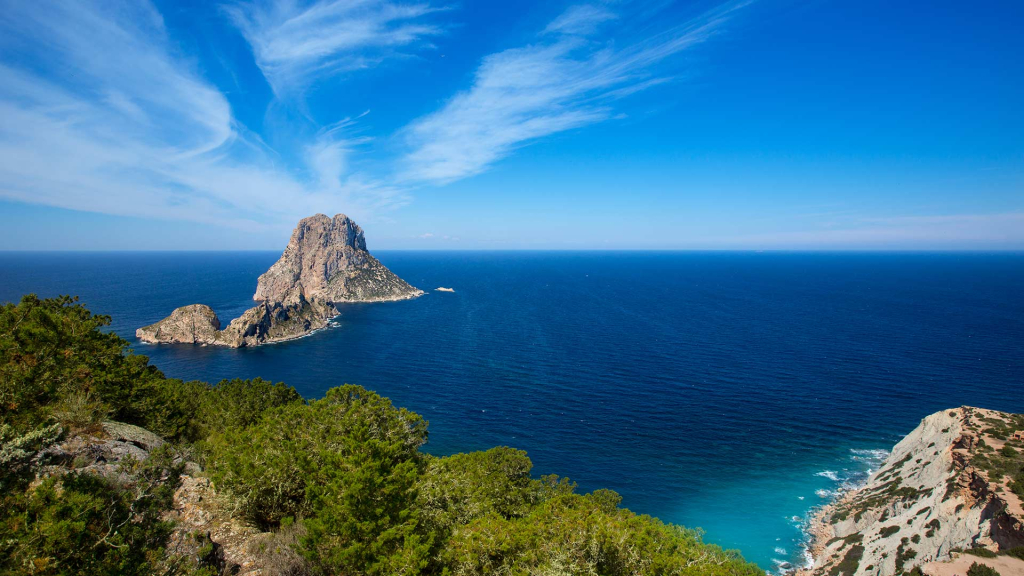
Ibizan nature stands as the main attraction of the island , highlighting its exuberant Mediterranean pine forests . The Greeks named Ibiza and Formentera the Pitiusas Islands, or "pine islands" , because of the green mantle that covers their fields and mountains throughout the year. Recent scientific studies date the presence of these pine trees on the island to 7,000 years ago , giving the landscape an incomparable beauty and authenticity.

Enjoying spectacular sunsets over the Mediterranean , immersing yourself in crystal-clear waters and exploring fields planted with wheat, vines and fruit trees are unique experiences that Ibiza offers. The aroma of aromatic plants such as thyme, rosemary and lavender perfumes the air , growing without order in every corner and adding a touch of charm to the atmosphere.
Fauna
The fauna of Ibiza is grouped into four different categories :
- The marine fauna is remarkably diverse around the Pitiüses, highlighting the colonies of seabirds, cetaceans and sea turtles.
- The faunas of continental waters are represented by various species of invertebrates, crustaceans, amphibians and marsh birds , with Ses Salines and Ses Feixes being the most important areas for these species.
- The terrestrial fauna , limited by the insularity and aridity of the climate , is home to endemic forms of great interest , with notable habitats on the coastlines, dunes, wetlands and forest ecosystems.
- The traditional cultivation area is also home to a significant zoological variety, including species that inhabit underground cavities.

Flora
The rich flora of Ibiza has nearly a thousand species , with a notable presence of Mediterranean elements that reveal its diverse biogeographic history . The island is home to a variety of aromatic plants, fruit trees and native species that contribute to its unique landscape.

Natural parks
Ibiza has natural areas of special interest, such as the Ses Salines Natural Park and the nature reserves of Es Vedrà , Es Vedranell and the Poniente islets . Ses Salines, located between the south of Ibiza and the north of Formentera , encompasses a variety of environments, from salt ponds to beaches, dunes and cliffs , home to species such as the peregrine falcon and the osprey . The nature reserves of Es Vedrà and the surrounding islets protect the valuable marine environment and the unique biodiversity of the region.
The Natural Reserve of Es Vedrà, Es Vedranell and the Poniente islets make up one of the most attractive large natural and protected areas on the island of Ibiza . The reserve is surrounded by virgin beaches, cliffs and a horizon full of imposing islets that make this place something unique and special in the world.
If you are passionate about nature, the sea and its surroundings , visiting the Natural Reserve of Es Vedrà, Es Vedranell and the Poniente islets is the ideal option to disconnect on vacation . In addition to being the most iconic image of Ibiza, es Vedrá has great biological value, both for its flora and its endemic fauna; sea birds, the pitiusa lizard and a wide variety of invertebrates that inhabit the islet.

Visiting the Ses Salines Natural Park of Ibiza and Formentera is one of the best experiences you can take from your trip. And between the two Pitiusas , you will find a natural space with a very rich ecosystem in which the ancient salt ponds transform the landscape into a postcard.
Its immense seabed covered with Posidonia Oceanica meadows makes its waters so crystal clear that diving and scuba diving become a privileged experience. Birdwatchers will enjoy spotting the migratory birds that rest and nest here. Flamingos, herons…
It is a paradise for ornithologists! And if this were not enough, Ses Salines is home to some of the most beautiful beaches in Ibiza and Formentera.

Birdwatching in Ibiza
Ibiza also has a wide variety of species that can be found in its diverse natural environment. One of the best places to watch birds in Ibiza is the Ses Salines Natural Park , a protected area that includes the Es Cavallet beach area and the Es Freus peninsula . One of the main characteristics of this area is the reception of important populations of nesting, hibernating and migrant aquatic and sea birds . Here you can see birds such as flamingos, yellow-legged gulls, sandy terns, shags, little egrets and white spoonbills .
Another recommended place for birdwatching in Ibiza is the Ses Feixes wetland , located in Talamanca Bay . This place is home to a wide variety of waterfowl, such as ducks, ducks, coots and stilts, among other species . It is also possible to see birds in the mountain areas of Ibiza , such as the Sierra de Santa Inés , where you can see species such as the Balearic warbler, the capuchin tit and the short-toed eagle.

In summary, Ibiza has a great variety of ecosystems that make it a privileged place in terms of biodiversity . From its rocky cliffs, beaches and coves, to its dense pine forests, almond and olive groves, and coastal wetlands . A whole range of landscapes that you can discover if you delve into Ibizan nature. The island has several protected natural spaces , such as the Ses Salines Natural Park , a space that encompasses a set of terrestrial and marine habitats , with ecological, landscape, historical and cultural values of the first order. The Es Vedrà Natural Reserve, Es Vedranell and the Poniente islets also stand out.

Explore nature at its best!

